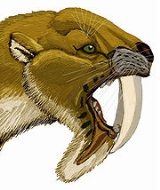
Sparassodonta
Encyclopedia
Sparassodonta is an extinct order
of carnivorous
metatheria
n mammal
s native to South America
. They were once considered to be true marsupials, but are now thought to be a sister taxon to them. A number of these mammalian predators closely resemble placental predators that evolved separately on other continents, and are cited frequently as examples of convergent evolution
. They were first described by Florentino Ameghino
, from fossils found in the Santa Cruz beds of Patagonia
.
Order (biology)
In scientific classification used in biology, the order is# a taxonomic rank used in the classification of organisms. Other well-known ranks are life, domain, kingdom, phylum, class, family, genus, and species, with order fitting in between class and family...
of carnivorous
Carnivore
A carnivore meaning 'meat eater' is an organism that derives its energy and nutrient requirements from a diet consisting mainly or exclusively of animal tissue, whether through predation or scavenging...
metatheria
Metatheria
Metatheria is a grouping within the animal class Mammalia. First proposed by Thomas Henry Huxley in 1880, it is nearly synonymous with the earlier taxon Marsupialia though it is slightly wider since it also contains the nearest fossil relatives of marsupial mammals.The earliest known...
n mammal
Mammal
Mammals are members of a class of air-breathing vertebrate animals characterised by the possession of endothermy, hair, three middle ear bones, and mammary glands functional in mothers with young...
s native to South America
South America
South America is a continent situated in the Western Hemisphere, mostly in the Southern Hemisphere, with a relatively small portion in the Northern Hemisphere. The continent is also considered a subcontinent of the Americas. It is bordered on the west by the Pacific Ocean and on the north and east...
. They were once considered to be true marsupials, but are now thought to be a sister taxon to them. A number of these mammalian predators closely resemble placental predators that evolved separately on other continents, and are cited frequently as examples of convergent evolution
Convergent evolution
Convergent evolution describes the acquisition of the same biological trait in unrelated lineages.The wing is a classic example of convergent evolution in action. Although their last common ancestor did not have wings, both birds and bats do, and are capable of powered flight. The wings are...
. They were first described by Florentino Ameghino
Florentino Ameghino
Florentino Ameghino was an Argentine naturalist, paleontologist, anthropologist and zoologist.Born in Luján, son of Italian immigrants, Ameghino was a self-taught naturalist, and focused his study on the lands of the southern Pampas...
, from fossils found in the Santa Cruz beds of Patagonia
Patagonia
Patagonia is a region located in Argentina and Chile, integrating the southernmost section of the Andes mountains to the southwest towards the Pacific ocean and from the east of the cordillera to the valleys it follows south through Colorado River towards Carmen de Patagones in the Atlantic Ocean...
.
Features
Although members of the order Sparassodonta showed many similarities with placental carnivores, they were not closely related and are a very good example of convergent evolution. For example, sparassodonts' molars were very similar to the sharp teeth of placental carnivores. The canines were also lengthened, and in some cases resemble those of saber-toothed cats. Their body size varied, ranging from 80 cm (2 ft 8 in) long to the size of today's modern big cats.Classification
- Order Sparassodonta
-
- Genus Pseudonotictis
- Genus Sallacyon
- Family Mayulestidae
- Genus Mayulestes
- Genus Allqokirus
- Family Hathliacynidae
- Genus Patene
- Patene simpsoni
- Patene coluapiensis
- Genus Palaeocladosictis
- Genus Procladosictis
- Genus Pseudocladosictis
- Genus Notogale
- Genus CladosictisCladosictisCladosictis is an extinct genus of South American metatherian.It was an otter-like creature of about 80 cm long. Its body and tail were long, the limbs were short. Cladosictis probably hunted small creatures in low undergrowth, using its low posture for cover. Possibly, it also stole bird and...
- Genus Sipalocyon
- Genus Thylacodictis
- Genus Agustylus
- Genus Ictioborus
- Genus Amphithereutes
- Genus Parathereutes
- Genus Chasicostylus
- Genus Notictis
- Notictis ortizi
- Genus Notocynus
- Genus Borhyaenidium
- Genus Patene
- Family BorhyaenidaeBorhyaenidaeThe borhyaenids, members of the Borhyaenidae family of metatherians , were a carnivorous group of otter/wolverine-shaped marsupials in the order Sparassodonta. They lived in the Miocene of South America . Like most metatherians, they had a pouch to carry their offspring around...
- Genus Nemolestes
- Genus Argyrolestes
- Genus Angelocabrerus
- Genus Pharsophorus
- Genus BorhyaenaBorhyaenaBorhyaena is an extinct genus of South American metatherian, living between 20 and 15 million years ago.Borhyaena was a large, bear-like marsupial predator of up to long and with an estimated average weight of . A typical borhyaenid, it had flat feet and a heavy build...
- Genus Acrocyon
- Genus Conodonictis
- Genus Eutemnodus
- Genus Parahyaenodon
- Family Proborhyaenidae
- Genus Arminiheringia
- Genus Paraborhyaena
- Genus Proborhyaena
- Family Prothylacinidae
- Genus Pseudothylacinus
- Genus Prothylacynus
- Genus Dukecynus
- Genus Lycopsis
- Genus Stylocynus
- Genus Pseudolycopsis
- Family Thylacosmilidae
- Genus AnachlysictisAnachlysictisAnachlysictis is an extinct genus of carnivorous mammal belonging to the group Sparassodonta, related to the current metatherian marsupials that inhabited South America during the Cenozoic...
- Genus Achlysictis
- Genus Amphiproviverra
- ?Genus Hondadelphys
- Genus Hyaenodontops
- Genus Notosmilus
- Genus Patagosmilus
- Genus ThylacosmilusThylacosmilusThylacosmilus was a genus of sabre-toothed metatherian predators that first appeared during the Miocene. Remains of the animal have been found in parts of South America, primarily Argentina...
- Genus Anachlysictis
-

